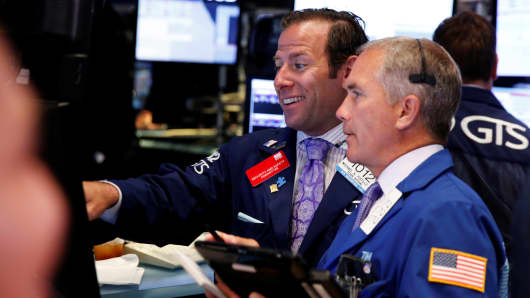Getty Images
U.S. stocks traded higher on Friday after the release of stronger-than-expected employment data.
The Dow Jones industrial average rose 200 points, with Intel as the best-performing stock in the index. The S&P 500 gained 0.8 percent, with energy as the best-performing sector. The Nasdaq composite advanced 0.9 percent. The Nasdaq 100, which is made up of the 100 largest companies in the Nasdaq composite, reached an all-time high.
The U.S. economy added 313,000 jobs in February, according to the Bureau of Labor Statistics. Economists polled by Reuters expected a gain of 200,000.
Wages, meanwhile, grew less than expected, rising 2.6 percent on an annualized basis. Stronger-than-expected wage growth helped spark a market correction in the previous month.
"As far as the market is concerned, you couldn't have scripted it any better," said JJ Kinahan, chief market strategist at TD Ameritrade. But "it still remains a mystery how you can create these many jobs and not have wages go up more."
The Dow Jones industrial average rose 200 points, with Intel as the best-performing stock in the index. The S&P 500 gained 0.8 percent, with energy as the best-performing sector. The Nasdaq composite advanced 0.9 percent. The Nasdaq 100, which is made up of the 100 largest companies in the Nasdaq composite, reached an all-time high.
The U.S. economy added 313,000 jobs in February, according to the Bureau of Labor Statistics. Economists polled by Reuters expected a gain of 200,000.
Wages, meanwhile, grew less than expected, rising 2.6 percent on an annualized basis. Stronger-than-expected wage growth helped spark a market correction in the previous month.
"As far as the market is concerned, you couldn't have scripted it any better," said JJ Kinahan, chief market strategist at TD Ameritrade. But "it still remains a mystery how you can create these many jobs and not have wages go up more."
The moves Friday came after Wall Street finished on a positive note on Thursday, following more developments concerning tariffs.
President Donald Trump signed two declarations on Thursday, which would implement tariffs on steel and aluminum imports. The tariffs are expected to take effect in 15 days and will put a 25 percent charge on steel, and 10 percent on aluminum. Canada and Mexico however are exempt.
"I'm glad to see Canada and Mexico was spared in the latest tariff initiatives," said Peter Boockvar, chief investment officer at Bleakley Advisory Group, in a note. "But, 75% of our trading partners were slapped. I get that China was the real target here but we import 13% of our steel from Brazil, 10% from South Korea, 5% from Japan, 4% from Germany and 3.5% from Taiwan to name some others."
Friday also marked the nine-year anniversary of the bull market. It also marks the "Haines Bottom." Before the open on March 10, 2009, CNBC anchor Mark Haines called the bottom of the financial crisis on air.
On March 9, 2009, the S&P 500 closed at 676.53. Since then, the S&P 500 is up around 300 percent.


No comments:
Post a Comment